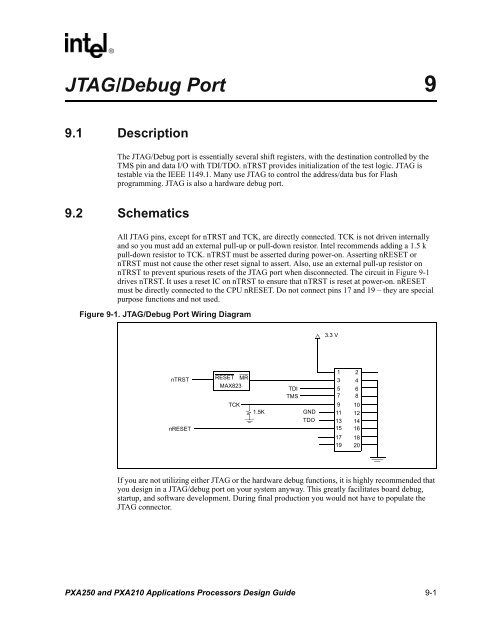Intel PXA250 and PXA210 Applications Processors
Intel PXA250 and PXA210 Applications Processors
Intel PXA250 and PXA210 Applications Processors
Create successful ePaper yourself
Turn your PDF publications into a flip-book with our unique Google optimized e-Paper software.
JTAG/Debug Port 9<br />
9.1 Description<br />
The JTAG/Debug port is essentially several shift registers, with the destination controlled by the<br />
TMS pin <strong>and</strong> data I/O with TDI/TDO. nTRST provides initialization of the test logic. JTAG is<br />
testable via the IEEE 1149.1. Many use JTAG to control the address/data bus for Flash<br />
programming. JTAG is also a hardware debug port.<br />
9.2 Schematics<br />
All JTAG pins, except for nTRST <strong>and</strong> TCK, are directly connected. TCK is not driven internally<br />
<strong>and</strong> so you must add an external pull-up or pull-down resistor. <strong>Intel</strong> recommends adding a 1.5 k<br />
pull-down resistor to TCK. nTRST must be asserted during power-on. Asserting nRESET or<br />
nTRST must not cause the other reset signal to assert. Also, use an external pull-up resistor on<br />
nTRST to prevent spurious resets of the JTAG port when disconnected. The circuit in Figure 9-1<br />
drives nTRST. It uses a reset IC on nTRST to ensure that nTRST is reset at power-on. nRESET<br />
must be directly connected to the CPU nRESET. Do not connect pins 17 <strong>and</strong> 19 – they are special<br />
purpose functions <strong>and</strong> not used.<br />
Figure 9-1. JTAG/Debug Port Wiring Diagram<br />
3.3 V<br />
nTRST<br />
RESET MR<br />
MAX823<br />
TDI<br />
TMS<br />
1<br />
3<br />
5<br />
7<br />
2<br />
4<br />
6<br />
8<br />
nRESET<br />
TCK<br />
1.5K<br />
GND<br />
TDO<br />
9<br />
11<br />
13<br />
15<br />
10<br />
12<br />
14<br />
16<br />
17<br />
19<br />
18<br />
20<br />
If you are not utilizing either JTAG or the hardware debug functions, it is highly recommended that<br />
you design in a JTAG/debug port on your system anyway. This greatly facilitates board debug,<br />
startup, <strong>and</strong> software development. During final production you would not have to populate the<br />
JTAG connector.<br />
<strong>PXA250</strong> <strong>and</strong> <strong>PXA210</strong> <strong>Applications</strong> <strong>Processors</strong> Design Guide 9-1
















